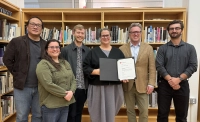
Inside the Virtual Architecture Studio: Rhino 3D, Unity, & More
Published
For many reasons the Bachelor of Virtual Architecture program is the degree of the future, but one of the most important is how it approaches software. While mastering an industry standard program is critical, it is more valuable to be flexible and adaptable to a variety of tools. Due to the rapid and fluctuating nature of the industry and range of speculation for what the future brings, Virtual Architecture students are prepared to be at the cutting edge of technology as it develops. As a student, you’ll take a unique approach to industry tools that goes beyond the standards, experimenting often with fledgling, new, untested, and developing technologies.
Which software is best for architecture?
Some software is considered fundamental to any education. In architecture, BIM (Building Information Modeling) softwares such as Revit dominate the field but aren’t as commonly taught in schools. Many students think this is counterintuitive, but the reality is Revit is tailored specifically to building and construction document production. However, the most important aspects to learn and teach in design school happen in the earlier conceptual stages of the project, for which other software is better suited. This isn’t just for architecture, but for all design disciplines where you may be challenged to design a building, but also a table, cup, or a neighborhood.
One software the Marywood Virtual Architecture students will learn well is Rhino 3D. This program is a time tested CAD (Computer Aided Design) software that is an excellent starting point for architecture and design students. It is a NURBS modeling tool, which stands for Non-Uniform Rational B-Spline, a way of defining space and objects with points, curves, and surfaces. In the beginning design classroom, it can create experimental forms and shapes, while being exacting enough to create physical models with CNC machining, laser cutting, or 3d printing. Lastly, it is a good baseline from which to branch out to coding, scripting, and more!
A different approach to 3D modeling is called polygon mesh modeling. In this type of program, space is defined by points - called vertices - that are woven together with other points to create faces and finally solids. The Virtual Architecture program will cover industry standard mesh modeling program Unity, the world’s most popular development game engine for creating 2D and 3D multiplatform games and interactive experiences.
All of this learning and design process education takes place during the most important course in the major, the design studio. Because of that opportunity, students in this program will not only learn those industry standard tools like the ones mentioned in this post, but be supported and encouraged to go wherever their curiosity takes them. This curiosity is paramount to the curriculum itself, and it’s a major factor in why the Virtual Architecture program is solidly within the future of education.
Request More Information about Marywood’s Virtual Architecture Program.
-
.jpg/200w/99q) Marywood PA Program Brings Holiday Cheer Through Angel Tree Initiative
Marywood PA Program Brings Holiday Cheer Through Angel Tree InitiativeMarywood PA students and faculty, led by Haley Jupina, brought holiday cheer to 94 children through their first-ever Angel Tree initiative—demonstrating the program’s commitment to service and community.
-
 AIA Pennsylvania Honors School of Architecture with 2025 Social Impact Award
AIA Pennsylvania Honors School of Architecture with 2025 Social Impact AwardThis honor is part of the AIA Pennsylvania Architectural Excellence Special Awards program, which recognizes outstanding contributions by individuals, organizations, and institutions that advance the built environment and the architectural profession across the Commonwealth.
-
 Marywood University’s John Maurer to Perform National Anthem at Boston Celtics Game
Marywood University’s John Maurer to Perform National Anthem at Boston Celtics GameJohn Maurer to perform the national anthem at the Boston Celtics game in January